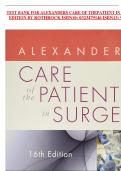Exam (elaborations)
Test Bank: Alexander's Care of the Patient in Surgery 16th Edition by Rothrock - Ch. 1-30, 9780323479141, with Rationales
Test Bank: Alexander's Care of the Patient in Surgery 16th Edition by Rothrock - Ch. 1-30, 9780323479141, with Rationales
[Show more]



